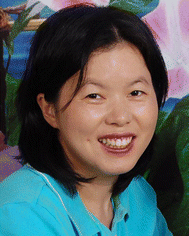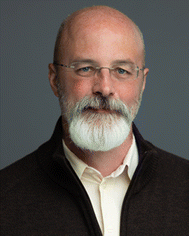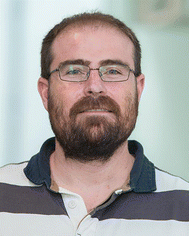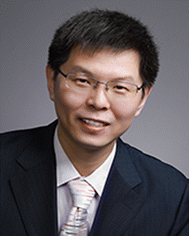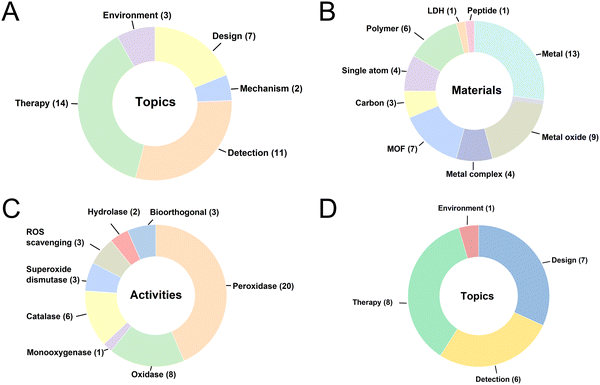Introduction to nanozymes
Shaoqin
Liu
 *a,
Vincent M.
Rotello
*a,
Vincent M.
Rotello
 *b,
Asier
Unciti-Broceta
*b,
Asier
Unciti-Broceta
 *c and
Hui
Wei
*c and
Hui
Wei
 *d
*d
aHarbin Institute of Technology, China. E-mail: shaoqinliu@hit.edu.cn
bUniversity of Massachusetts, USA. E-mail: rotello@chem.umass.edu
cUniversity of Edinburgh, UK. E-mail: asier.ub@ed.ac.uk
dNanjing University, China. E-mail: weihui@nju.edu.cn
Nanozymes are nanomaterials with enzyme-like characteristics.1 They have been employed to address the intrinsic limitations of enzymes and conventional artificial enzymes. In recent years, dramatically increasing research interest has been attracted to the field of nanozymes. This themed collection (Nanozymes) highlights the substantial progress made in the field.
For this collection more than 70% of the publications are original studies, covering topics from nanozyme design and mechanisms to their applications (Fig. 1A). A large number of these papers are focused on detection and therapy, while environmental protection is also represented, consistent with this emerging application. To date, numerous types of nanomaterials have been exploited to mimic enzymes. Currently, metals, metal oxides, and metal–organic frameworks (MOFs) are most heavily represented, while others are also good candidates, including metal complexes, polymers, carbon, single atoms, layered double hydroxides, and peptides (Fig. 1B). Clearly, most of the studies are focused on oxidoreductase-like activities, ranging from peroxidase, oxidase, monooxygenase, and catalase to superoxide dismutase and ROS scavenging activities (Fig. 1C). Notably, hydrolase-like nanozymes and bioorthogonal nanozymes have also been investigated by several groups. Over ten reviews (including perspectives and minireviews) are included in the collection. They cover the topics of design, detection, therapy, and environmental protection (Fig. 1D). The range of functionalities embodied by nanozymes are evidence of the versatility and scope of the technologies that fall under this banner.
As mentioned above, an important proportion of manuscripts of this themed collection have focused on tackling biomedical problems. Scientists have long sought to build miniaturized devices with medical capabilities that can be inoculated into patients to track and treat disease with high precision. While there is still a long way to go, several works from this collection showcase recent advances towards the goal of performing precise theranostic tasks through nanodevices with enzyme-like functionalities. The catalytic capabilities of nanozymes bring the generation of therapeutics and imaging agents to the site of the disease, be it cancer, inflammation, or other illnesses. Biomimetic nanozymes also provide new pathways to generating reactive species that can kill cells or modulate their activity. Bioorthogonal nanozymes provide in situ ‘drug factories' that generate drugs and imaging agents where they are needed. Both biomimetic and bioorthogonal strategies open up new therapeutic modalities with the potential to improve disease treatment while minimizing off-target effects. Besides the above interesting applications in detection and therapy, new applications of nanozymes are emerging. For example, nanozymes have been developed for environmental remediation. The combination of photocatalytic nanozymes with sunlight would provide a robust and sustainable way for future environmental protection. It should be noted that more applications could be explored in the near future, including but not limited to environmental monitoring and antibiofilm applications.
With over 59 articles accepted to date, the interest attracted by this cross-journal collection has far exceeded our expectations. It denotes –nonetheless– the good health of this fascinating, ever-growing topic, which intertwines so many fields of research. We thank the authors for their interest in this initiative and congratulate them for the quality of their work. Nanozymes are working harder than ever.
References
- H. Wei and E. Wang, Chem. Soc. Rev., 2013, 42, 6060–6093 RSC.
| This journal is © The Royal Society of Chemistry 2023 |

